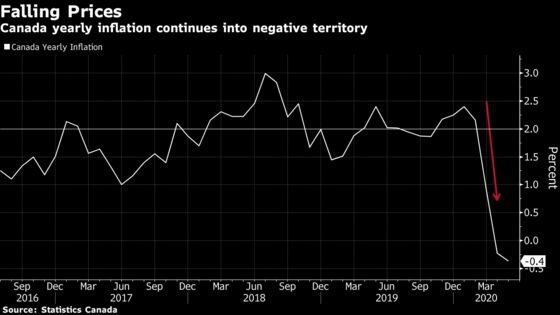Inflation Falls Further in Canada After Retailers Drop Prices
Canada Inflation Goes Further Into Negative Territory in May
(Bloomberg) -- Inflation moved further into negative territory as Canada’s retail stores began to reopen from the Covid-19 lockdowns with discounts to entice shoppers.
The consumer price index dropped 0.4% from the same month a year earlier, Statistics Canada reported Wednesday from Ottawa. That compares with a 0.2% drop in April. Inflation was running at 2.2% as recently as February. From April, prices climbed 0.3%, compared with a forecast of 0.7%.
Provinces across the country began reopening in May and the latest inflation data suggest retailers lowered prices to encourage sales. Prices for women’s clothing fell 3.9% in May from April and footwear prices dropped 2.9%.

“We expect an ongoing shortfall in demand will make for a slow return to the BoC’s 2% inflation target,” Josh Nye, senior economist at RBC Economics, said in a report to investors. “The upshot is that ongoing monetary policy stimulus will be required to get the economy back to full capacity and inflation back on target.”
Canada’s currency depreciated after the report and was trading 0.2% lower at C$1.3565 against its U.S. counterpart at 10:47 a.m. Toronto time. The yield on two-year government bonds was down 1 basis point to 0.29%, while the 10-year yield fell 2 basis points to 0.53%.
Lower prices for furniture, rent and telephone services were also primary contributers to the weaker May reading.
Gasoline prices, a main factor in the lower inflation readings in March and April, picked up in May with higher international demand. Still, compared with a year ago they remain depressed, driving the annual CPI rate lower. Economists expected annual inflation would be 0% in May, according to the median forecast in a Bloomberg survey.
Core inflation readings, often seen as a better measure of underlying price pressure, declined to 1.67% in May, the lowest since December 2017, down from 1.8% in the prior month.
Compared with last year, consumers paid more for meat following supply chain disruptions, plant closures and a weaker Canadian dollar. Canned tuna, flour and rice prices also rose, coinciding with higher demand for non-perishables amid the pandemic, Statistics Canada said.
The agency said it will begin publishing new inflation data that better capture changes in consumer behavior during the coronavirus crisis. Statistics Canada is working with the Bank of Canada in “exploring ways to use current, ad hoc sources of expenditure data to estimate CPI basket weights that reflect shifting consumption patterns during the pandemic.”
©2020 Bloomberg L.P.